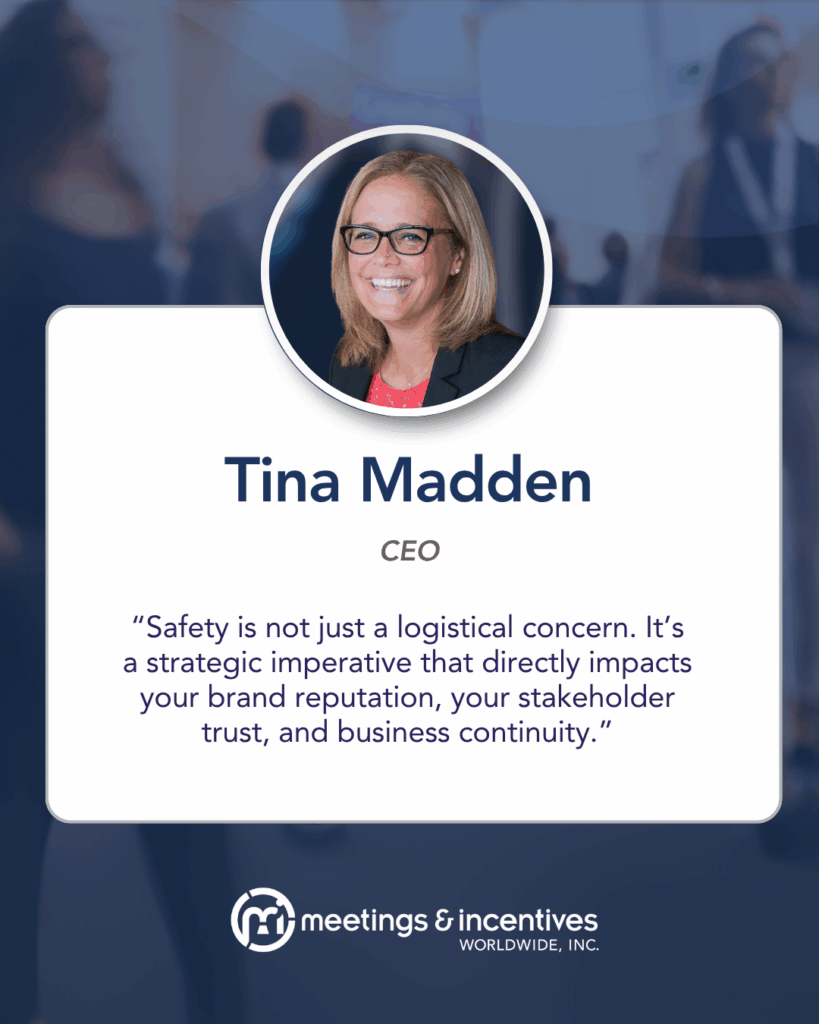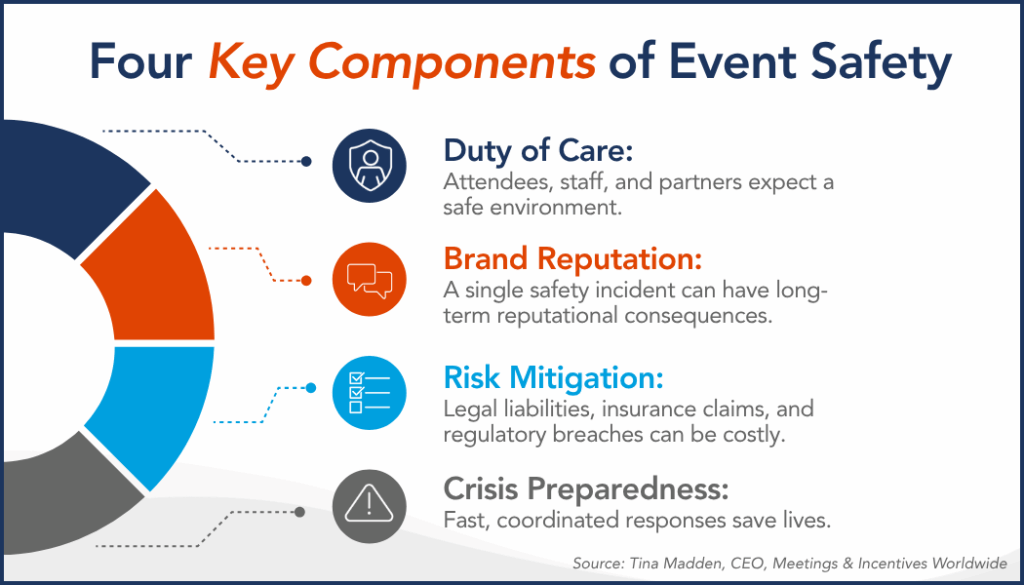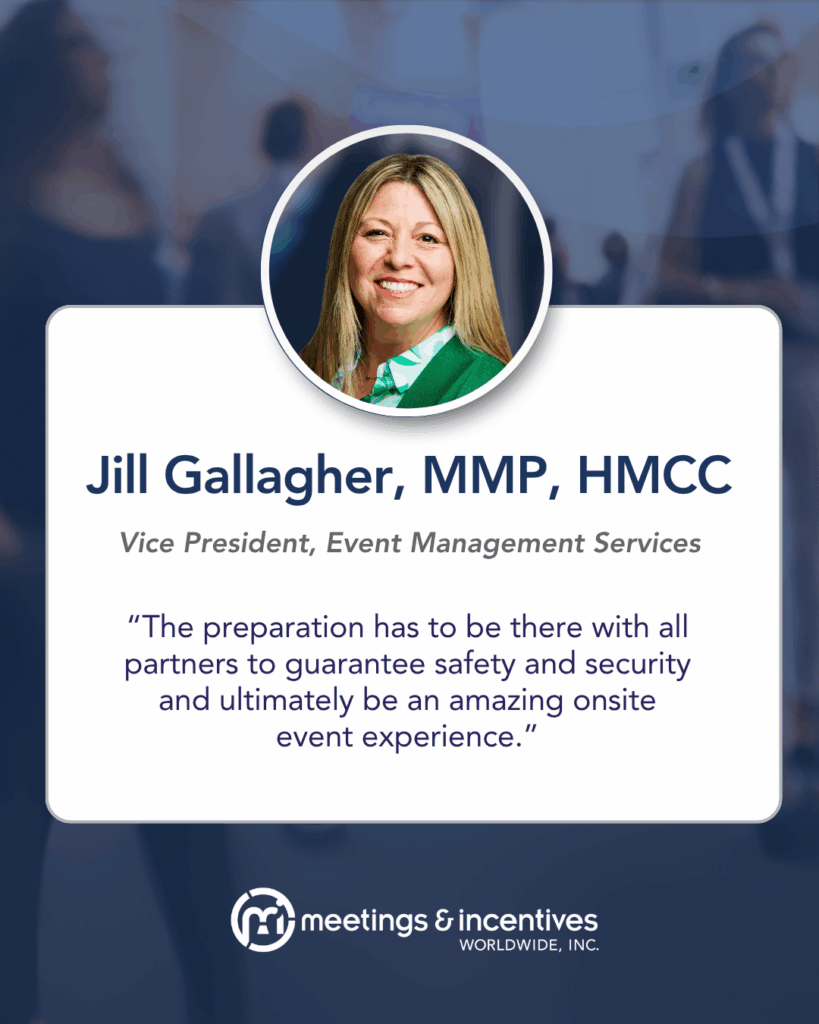Event Emergency Preparedness: What to Know for 2026
As a premier event management company, Meetings & Incentives Worldwide doesn’t just design experiences; we safeguard them. That’s why we hosted “Event Emergency Preparedness: What to Know for 2026,” a LinkedIn Live session featuring M&IW’s CEO Tina Madden and Vice President of Event Management Services Jill Gallagher, MMP, HMCC.
Drawing from real-world case studies and decades of industry expertise, Tina and Jill shared actionable strategies to help event planners and owners navigate today’s complex safety environment, from evolving communication needs to customizing emergency plans and more.
This blog distills the top takeaways from their discussion, offering forward-thinking recommendations to help you build resilient, responsive safety plans for your events in 2026 and beyond. Whether you’re planning a 100-person meeting or a 10,000-person conference, now is the time to elevate your emergency preparedness strategy and empower your team to lead with confidence.
For all insights from the live event, click the button below to watch the on-demand recording or download our resource document that builds upon the key learnings.

The Importance of Event Emergency Safety
“Safety is a key foundation to any successful event,” said Tina. When attendees are safe and feel secure, they can fully engage, connect, and enjoy the experience.
“Safety is not just a logistical concern,” continued Tina. “It’s a strategic imperative that directly impacts your brand reputation, your stakeholder trust, and business continuity.”
Tina identified four key areas to prioritize when considering event safety: duty of care, brand reputation, risk mitigation, and crisis preparedness.

How Event Safety Has Changed
The event kicked off by discussing how event safety has changed in the past year and how to update emergency preparedness protocols accordingly.
Increases in Protests and Live Disruptions
“Event safety in 2025 and going into 2026 has undergone significant [changes],” said Tina. Factors like “volatile political environment and very scary public situations [add] new complexities… as well as anxiousness from attendees.”
Jill shared an example from an M&IW senior leader who attended a recent event where protesters took over the stage. Attendees were unsure if it was a skit, the speaker was frozen onstage, and no one knew what to do.
“It was a little bit of paralysis,” said Jill. “There was no immediate action when everything went off course, so that was a bit of an eye opener.”
As these live disruptions become if not more common, then at least more possible, it’s important to know how to both prepare for the possibility and react in the moment.
How to Respond to Disruptions
“You want to immediately contain the situation,” said Jill. “Try to isolate whatever is going on… and then try to maintain normal as best we can.”
In the example of protesters, remove their audience by physically evacuating attendees or taking away the protesters’ visibility by turning off stage lighting.
Jill also recommended preparing in advance the following communication tools that can be used in multiple situations:
- Voice of God (VOG) recordings directing attendees to either evacuate or stay in place.
- Premade slides with directions for emergency exits, in multiple languages if needed.
- Communication plans between onsite leads, tech booths, registration desks, and onsite security teams.
Customizing Event Safety Strategies
With these changes in mind, a generic emergency planning checklist is no longer sufficient. That doesn’t mean you shouldn’t prepare, but not every event needs the same requirements.
“You can’t have a one-size-fits-all [emergency plan],” said Tina, “but doing nothing is not the answer, either.” She suggested establishing a decision tree to analyze and assess the risks for each event based on multiple factors.
Jill agreed, mentioning the decision tree should include factors such as event size, audience demographics, attendee base, destination, venue, and even the current corporate climate.
How to customize your safety plans and what to include in your decision tree are shared in more detail in our emergency preparedness resource document. Click here to download the document.
The Responsibility of Event Safety
A common question during emergency preparedness planning is, who is responsible for event safety and duty of care? According to Tina and Jill, the answer is everyone.
“We are looking at this as an entire ecosystem,” said Tina. “Safety has to be part of every partner or supplier within the event… Everyone has to have some level of responsibility and understanding, and the attendee as well.”
That doesn’t mean everyone does everything. It means building strong, trusted partnerships with clear expectations and communication.
“Lack of communication across anyone in that ecosystem really can cause delays in a response time if there actually is an emergency,” Tina added.

Partnering for Safety
“It is shared accountability without a doubt,” agreed Jill. “I look at it like a recipe. Individual ingredients on their own don’t amount to anything. Everything has to be seamlessly integrated… The preparation has to be there with all partners to guarantee safety and security and ultimately be an amazing onsite event experience.”
For example, the onus for safety isn’t all on the hotel or venue; they’re focused on total operations, not exclusively your event. Even if a hotel has a security team, it’s important to verify roles and responsibilities. Is their security team 24/7 or only overnight? Is it a robust team or just one person doing rounds? Different answers require different plans.
In another example, production companies should always be looped into the run of show, including “surprise” elements, so if something goes wrong or seems off, they’re already alert and can communicate with the onsite lead or stop the event if needed.
Top Recommendations for Event Emergency Preparedness
When asked for their top recommendations for emergency preparedness in 2026, Tina and Jill identified five key areas: customization, scalability, partnership, practice, and communication.
“Definitely think about a tiered plan,” said Tina. “Base it on level of risk and then make sure you include all partners. [Make sure] communication is clear and accountability is clear…. [Also,] having conversations and practicing. The more muscle memory, the better, so if you have to go into action, you don’t panic.”
Jill agreed and added, “Security is never one-size-fits-all. Attendee safety communication shouldn’t be, either. We need to make sure that everything we’re doing is fully accessible to people… We want to meet people where they’re at.”
Elevating Your Event Safety Strategy
Whether you’re planning a small meeting or a large event, Tina and Jill offer practical strategies to elevate your event safety protocols. Other topics discussed during the live event include:
- Recommendations to improve security for small meetings.
- How to navigate national or international emergencies that occur during your event.
- Resources and online tools for both planners and attendees.
- How to balance the perception versus reality of event safety.
Don’t miss the chance to strengthen your planning toolkit. Watch the on-demand recording and download the resource guide to elevate your event emergency preparedness. Click the button below to access both resources as well as M&IW’s white paper on event emergency preparedness.
Related Articles
- M&IW Publishes White Paper on Event Emergency Preparedness Planning
- Meeting Professionals’ Responsibility to Fight Human Trafficking
To stay up to date on the latest trends and insights in corporate meetings, events, and incentives, follow us on LinkedIn.


